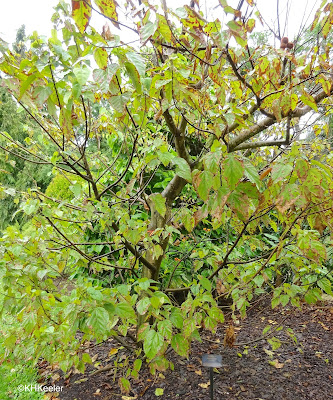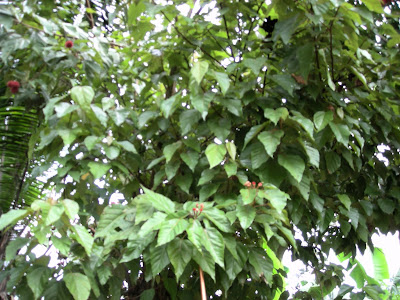Most dye plants are subtle. To get red from madder (Rubia tinctoria), the greatest red dye plant, you have to dig up the roots, cook them for an hour, and add a mordant. Annatto, known as lipstick tree, and achiote (Bixa orellana in the plant family named after it, Bixaceae) has big spiny red fruits that if you open them, smear red all over your hands. Not a bit subtle. Of course people tried it as a dye.
 |
annatto Bixa orellana seed pod,
about 2" long |
The red dye is the source of the common name, lipstick tree. There are other plants called lipstick, for example
Aeschynanthus, the lipstick plant, whose buds look like a tube of lipstick. However, they just look like lipstick while annatto is used as lipstick and in lipstick. You very much can spread it on your lips as lipstick, right out of the fruit. And get it all over your hands and be searching for something to wipe your hands on so as not to have red
everywhere. It is also an ingredient in commercial lipsticks. The active dye, bixin, is safe to consume and so is a preferred dye for foods and cosmetics.
The scientific name
Bixa is based on the native name of the plant, probably from Nauhautl, language of the Aztecs. The specific epithet,
orellana, honors Francisco de Orellana (1511-1546), the Spanish explorer who discovered the Amazon River.
 |
| Annatto tree. It has brown fruits in the upper right. |
 |
| Annatto, those are flowers or immature fruit, small and red. |
Annatto is a shrub or small tree, thought to be native across a wide area of South and Central America. It grows in places of warm temperatures, abundant rainfall, and bright sunshine. It probably grew in rainforest gaps, but humans have been moving it around for millennia. It is mentioned in Mayan prophesies from the 5th century. The plant was sacred in many American cultures, from the Mayas and Aztecs in Mexico, the Palikur of the Guianas, throughout the Amazon, and south to the Guaranis of Paraguay, northern Argentian and southern Brazil. People painted holy objects and themselves with annatto.
Annatto was mainly used as a dye--for people, food, and objects. It will make a color from brilliant red to bright yellow, and properly treated, various vibrant tans. It does not require a mordant; color variety is created with pH and additives. It was taken back to Europe early in the 15th century. It is not as colorfast as Europe's regular dyes of the time, but because the color was so fine, was used on silk where "when it comes to dyeing silk, beauty is always preferred over fastness." (Macquer 1763 in Cardon reference below).
 |
| Annatto pod showing seeds inside |
 |
| Annatto pods on big tree |
It had a range of medicinal uses in Central and South America. It was used as sun screen--being painted red was more than just ornamentation. It was used to treat skin problems, eaten to cure dysentery, and gargled for throat problems. It was added to soap (for color and medicinal properties) and used to dye hair. Fibers from annatto were woven into string and twine, and the bark produces a gum similar to gum arabic.
Today you can buy it as achiote, a spice made from the ground seeds that is widely used in cuisines across the American tropics. It is present as the yellow or orange dye in commercial food products from cheese and butter to rice to processed meats. And many cosmetics are dyed with annatto.
This is a small tree, made distinctive by the spine-covered fruits, which turn brown when they ripen and then split open revealing the bright red seeds (actually it is an aril that covers the seeds that is red). It attracts diverse pollinating bees.
In the Americas, an array of insects eat the leaves and damage the seeds. The trees have nectaries (sugar-producing glands, extrafloral nectaries) on the leaves, stems, and at the base of the flower. These attract ants. The ants drive off or eat insects feeding on annatto; trees with lots of ants have less damage to leaves and seeds. The spines on the seed pod likely protect the seeds while they are ripening. People can successfully grow annatto in cow pastures because the leaves contain enough calcium oxalate crystals (sour and will burn the mouth) to discourage grazing by cattle. If that sounds like a lot of defenses for one plant, yes. but that is typical of tropical plants, where the plant-eating animals are active year round, day and night.
This is one of the plants I think of as a toy, wanting to have a lot of seed pods to play with, getting dye all over everything. I have made a mess with it once or twice, but not nearly often enough. Watch for it.
 |
| Up above, annatto pods, identifying this tree. |
Comments and corrections welcome.
References
Bentley, B.L. 1977. The protective function of ants visiting the extrafloral nectaries of Bixa orellana (Bixaceae). Journal of Ecology. 65 (1): 27-38.
Cardon, D. 2007. Natural Dyes. Archetype Publications, London.
Duke, J.A. and R. Vasquez. 1994. Amazonian Ethnobotany Dictionary. CRC Press, London.
Missouri Plant Finder. Bixa orellana. Missouri Botanical Garden. link (Accessed 1/16/21).
Zuchowski, W. 2007. Tropical Plants of Costa Rica. Cornell University Press, Ithaca, NY.
Kathy Keeler, A Wandering Botanist
More at awanderingbotanist.com
Join me on Facebook: https://www.facebook.com/AWanderingBotanist






This comment has been removed by the author.
ReplyDeleteThanks for the information it really helped me to know about Plants. Have a look at lipstick plant varieties it is about plants and health related knowledge.
ReplyDeleteThis comment has been removed by the author.
ReplyDeleteWhat an awesome job you did here for us. So, innovative, creative and inspiring. The red dye lipstick color and tree details you explained in this post was really a new experience for me. You revealed some good information to learn regarding the dye plat especially lipstick or annatto. The seed pod, trees, seed inside related photos also looks very interesting. Not only coloring agent it can works for many purpose like in dairy industry, bakery items, source of vitamin B, healthy skin, boosts digestion decreases heartburn, for bone strength and the essential part of Ayurveda, For anti-parasitic activity Annatto seed is 100% proven. It is indeed a beneficial seed. Anyway, I enjoyed your rich post very much.
ReplyDeleteThis comment has been removed by a blog administrator.
ReplyDelete